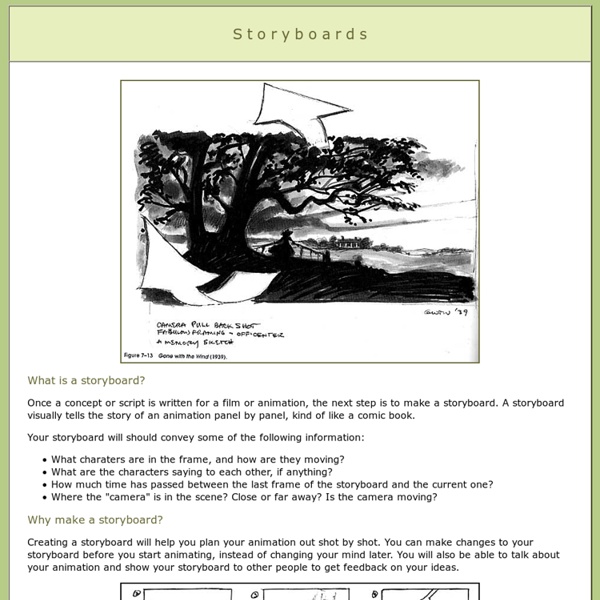EXO
Storyboard language
Basic definitions of terms[edit] Aerial shot: A shot taken from a plane, helicopter or a person on top of a building. Not necessarily a moving shot. Backlighting: The main source of light is behind the subject, silhouetting it, and directed toward the camera. Bridging shot: A shot used to cover a jump in time or place or other discontinuity. Examples are the falling calendar pages, railroad wheels, newspaper headlines, and seasonal changes. Camera angle: The angle at which the camera is pointed at the subject: Low High Tilt. Cut: The splicing of two shots together. Cross-cutting: Cutting between different sets of action that can be occurring simultaneously or at different times, (this term is used synonymously but somewhat incorrectly with parallel editing.) Continuity cuts: These are cuts that take us seamlessly and logically from one sequence or scene to another. Deep focus: A technique in which objects very near the camera as well as those far away are in focus at the same time.
How to Create a Course Podcast with Dropbox
This will be the first of a series of posts where I will share step-by-step tips for some customized online course development practices that I’ve recently attempted and found to be successful in my own online courses. Many of these tips will specifically deal with building a course in Blackboard, but the principles can certainly be applied to course design within other learning management systems. For years, I’ve been a big fan of podcasts and have found them to be a fantastic tools for professional development as well as for fostering “presence” in my blended and online courses. As an auditory learner myself, I prefer to learn through audio in conjunction with text and have for years looked for ways to incorporate audio into my teaching. While podcasts may not be for everyone, there is indeed no shortage of literature on podcast or evidence pointing to the educational benefits of podcasting. Podcasts, whether they be audio or video, are viewable either online or a mobile device.
Intro au SEP destinée aux acteurs de la FP en entreprise - Blog de C Campus
Le sentiment de compétence ou d’efficacité personnelle est un concept majeur, pourtant assez peu connu des praticiens en formation. Il est issu essentiellement des travaux du psychologue socio-cognitiviste Albert Bandura. Le sentiment d’efficacité personnelle plus important que la compétence elle-même ? Selon Albert Bandura, le sentiment d’efficacité personnelle, c’est-à-dire la croyance en sa capacité à réussir une tâche est prédictive de la réussite. Maîtriser des compétences pour réaliser une tâche n’est donc pas suffisant, encore faut-il se sentir capable de pouvoir les mobiliser. Se basant sur de multiples études et résultats de recherche, Albert Bandura propose ainsi un modèle de la performance humaine à trois dimensions dont le SEP (Sentiment d’efficacité personnelle) est déterminant. Une portée essentielle pour la formation Le concept de SEP nous invite à poser un autre regard sur la question de l’apprentissage au sein d’une entreprise. Troisième source : la persuasion par autrui.
Jet Stream
Jet Stream The main jet streams flow from the west in the upper atmosphere. Jet streams are fast flowing, relatively narrow air currents found in the atmosphere at around 11 kilometres above the surface of the Earth, just under the tropopause. They form at the boundaries of adjacent air masses with significant differences in temperature, such as of the polar region and the warmer air to the south.The major jet streams are westerly winds (flowing west to east) in both the Northern Hemisphere and the Southern Hemisphere; this is due to the Coriolis Effect caused by Earth's rotation. Jet streams can be explained as follows. The jet streams were first noticed by atmospheric scientists in the 19th century using kites and, later, pilot balloons, but before widespread aviation the so-called "high winds" (or "strong westerlies") were of little interest, and many observers thought that individual observations were simply freak occurrences. Wikipedia ShareThis
Apprentissage vicariant et SEP (Bandura) blog Pedagogeek
Publié par PedagoGeeks le 15 janvier 2012 | Dans les catégories suivantes Théories de l'apprentissage Bandura : L’apprentissage vicariant et le sentiment d’efficacité personnel. Albert Bandura est un psychologue canadien né en 1925. Il est professeur à l’Université de Stanford depuis 1953. Peu connu des pédagogues, ses travaux qui se situent à la frontière entre le béhaviorisme et le constructivisme, concernent le champ social de l’apprentissage. Du premier mouvement pédagogique, Bandura va retenir les effets de renforcement. Par extension, l’apprentissage vicariant a mis en évidence l’importance de la perception qu’un individu a de ses capacités. Le chercheur écrivait ainsi en 2003 dans son ouvrage « Le Sentiment d’Efficacité personnel » : « Les théories psychologiques ont traditionnellement mis l’accent sur l’apprentissage par les effets des actions de l’individu. Quelles sont alors les implications de cette théorie dans le cadre éducatif ?
managers
LES TECHNIQUES PEDAGOGIQUES
KAI-SEHUN-BACON



